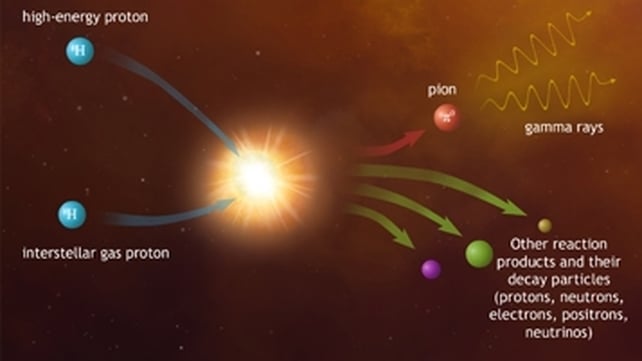Incredibly high energy particles bombarding Earth are likely to be coming from a supermassive black hole located near the centre of our Milky Way galaxy, new research by an Irish based scientist and his colleagues has concluded.
The study, carried out by an international collaboration using the H.E.S.S observatory in Namibia, claims the Sagittarius A black hole is acting like an accelerator, speeding up protons, electrons and atomic nuclei to unprecedented energies.
The Earth is constantly bombarded by high energy particles – known as cosmic radiation.
But it is difficult to determine where they come from, as the electrically charged particles are bent and deflected by the magnetic fields across the galaxy as they travel.
As a result, scientists who study cosmic physics have for over a century been perplexed by the mystery of their source.
However, the cosmic rays produce gamma rays when they interact with light and gas and these rays aren’t warped by magnetic fields.

As a result, the High Energy Stereoscopic System observatory or H.E.S.S in Namibia is able to detect super high energy gamma rays when they crash into Earth’s upper atmosphere and produce a short pulse called a Cherenekov light.
In turn scientists can then determine where the rays are coming from, and have identified 100 sources using the H.E.S.S. facility in the last 30 years.
The remains of supernova and pulsar wind nebulae are known to produce reasonably high energy cosmic rays.
However, researchers have theorised that even higher energy rays should exist and have even detected some.
Until now, though, they haven’t managed to isolate a source.
But Felix Aharonian from the Dublin Institute of Advanced Studies and colleagues think they may have discovered it.
In a paper published in Nature, the scientists claim that within the central area of the galaxy around 33 light years in size there is a source capable of accelerating protons to massive energies.

The researchers describe the source as a “Pevatron” as it is capable of accelerating protons to energies of one petaelectronvolt or PeV.
The team say there are many objects in the region capable of producing cosmic rays at Pevatron energies, but has a particular view of what source is most likely responsible.
“The supermassive black hole located at the centre of the Galaxy, called Sagittarius A*, is the most plausible source of the PeV protons”, says Felix Aharonian
“Several possible acceleration regions can be considered, either in the immediate vicinity of the black hole, or further away, where a fraction of the material falling into the black hole is ejected back into the environment, thereby initiating the acceleration of particles”.
The particular protons detected by the H.E.S.S which are thought to come from SagittariusA* do not, however, account for the total amount of cosmic rays detected on Earth.
But the researchers say this could be because the supermassive black hole was more active in the past, and that this activity is what is being detected on Earth today.
If true, this would dramatically influence the century old debate concerning the origin of these enigmatic particles, the researchers say.

